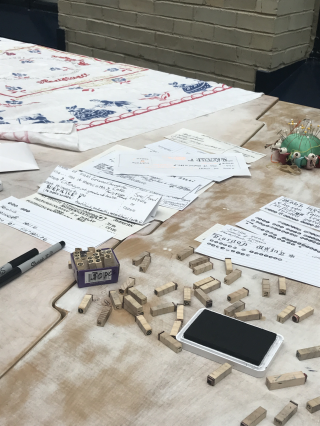
/movement dec 6 '17
Where do you see the history of resistance in your food? Working alongside the Kitchen’s theme of resistance, Shari Hersh of Homestudio-Lab, led an interactive quilting workshop to invite visitors to dig into their own food stories and histories using the prompts of the Kitchen. Shari invited visitors to think of recipes that served as forms of resistance for them and write out the name of the dish, what it’s main parts are, where they eat it, who they eat it with, what it means to them, and what community or tradition it belongs to. Guests would write out short but descriptive lines and then stamp out the lines onto a piece of paper to be added to the panorama timeline and then stamp them out again on a piece of fabric to be sewn on to the resistance fabric work. The piece falls somewhere between a quilt and a table runner and has questions and prompts about resistance embroidered onto it.
Digging into my own food history isn’t something I, and likely most people, think about very seriously without prompting. With a bit of thought, however, it is easy to find value, strength, importance, and empowerment through food. It is also possible to find and acknowledge the effects of violence, racism, sexism, and classism in food. The dishes or resistance that guests thought from their lives were vastly different and dealt with issues across spectrums. They ranged from ‘meeting snacks’ of dried fruits and nuts at meetings organized around how to protect undocumented people, to the mixed greens featured in the Kitchen that is the legacy of Black American foodways (with a hearty dose of potlikker for your health). My own personal recipe would be a corn and tomato salad, eaten with my family and friends at a summer cookout, made with fresh sweet corn and tomatoes from the family farm down the road - daily resisting the destruction of the soil in my hometown to development, natural gas, and the agro-industrial economy. The stamping part of this activity is methodical and leads to some great conversation while visitors are working. We talked about our own histories, how we got to the exhibit that day, the history of Philadelphia Assembled as a project, and how it might change the course of how art exhibitions are created in the future.
Digging into my own food history isn’t something I, and likely most people, think about very seriously without prompting. With a bit of thought, however, it is easy to find value, strength, importance, and empowerment through food. It is also possible to find and acknowledge the effects of violence, racism, sexism, and classism in food. The dishes or resistance that guests thought from their lives were vastly different and dealt with issues across spectrums. They ranged from ‘meeting snacks’ of dried fruits and nuts at meetings organized around how to protect undocumented people, to the mixed greens featured in the Kitchen that is the legacy of Black American foodways (with a hearty dose of potlikker for your health). My own personal recipe would be a corn and tomato salad, eaten with my family and friends at a summer cookout, made with fresh sweet corn and tomatoes from the family farm down the road - daily resisting the destruction of the soil in my hometown to development, natural gas, and the agro-industrial economy. The stamping part of this activity is methodical and leads to some great conversation while visitors are working. We talked about our own histories, how we got to the exhibit that day, the history of Philadelphia Assembled as a project, and how it might change the course of how art exhibitions are created in the future.
Samantha Heth